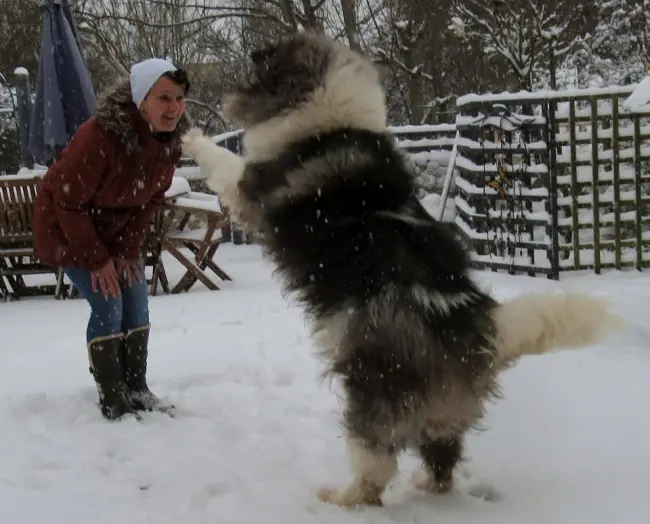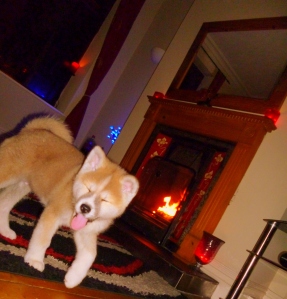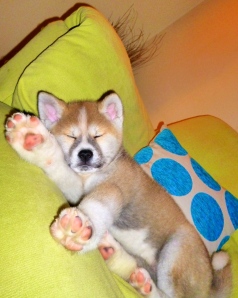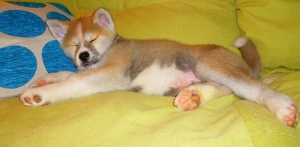Blog Archives
What’s a Longcoated Akita? (LC Akita)
The Long-coated Akita. There are many theories on how the long-coated Akita came to be, many believed that in the 1900s the Karafuto dog was introduced into the Akita bloodline. The Karafuto was a spitz type hunting dog, with small pointed triangular ears, hair was long, fine and thick with a very dense undercoat. These attributes are very similar to the Long-coated Akita. The Long-coat has many variations in coat length, from a slight feathering, to a huge wooly coat, sometimes reaching down to the Akitas feet. The coat will feel softer and silkier than the short coat due to the longer guard hairs and very dense undercoat, they have a very loving and kind disposition, are larger boned and extremely eager to please when it comes to training. Most breeders agree they are gentler by nature than their short-coated counter parts. The Long-coated Akita resemble extremely large cuddly teddies and are people magnets, But they are still a full bloodied Akita and will need the same levels of training and socialization, if not more so as people are drawn to them. They are often referred to as woolies or silkies, requiring a little more grooming than the short-coat. If left unkempt they will become matted and tangled, which is very uncomfortable for the Akita. They make excellent companions, whilst maintaining the characteristics of the short-coat. They have a high instinct to protect family members, quietly watching for threats, whilst appearing relaxed. They also make excellent guard dogs.Whilst the Long-coated Akita is considered a blatant fault with the majority of Judges, the Long-coat much to popular belief can be shown, But considering all the faults and disqualification within the breed, there is a huge stigma surrounding the Long-coat and it is almost never seen in the ring. In fact, until recently most people weren’t aware they even existed. This said, many breeders will have long-coats in their litters and most lines carrying the recessive gene will have fuller thicker coats. There have been a few petitions to get the Long-coated Akita recognized in a classification of it’s own and many believe these beautiful creatures should be seen in the ring. Although this throws up a lot of heated debate due to the variation in coat lengths and many breeders also fear the long-coat would become more popular than the short due to their heightened appeal.
soo watch this space !!
Written By Koda Naiya Sharpin Vez
Should i breed my Akita?
Put bluntly, there are currently too many poor quality AKITAS being bred simply for commercial purposes. These AKITAS are then sold on to naive, unprepared new owners with little knowledge or understanding of the breed and when the “cute” puppy becomes a big mischievous teenager, that is when they are likely to be sold on or given up to the already over run, crowed Akita rescues for rehoming!
If you are thinking of breeding your Akita dog/bitch, these are some of the things you need to think about:
1. How do you know your Akita dog/bitch is good enough to breed from?
In order to ensure that the Akita breed retains the qualities which make it what it is, any Akitas bred from need to be as close to the breed standard as possible. How do you know if your dog is good enough? The best way of ascertaining this is to both show and work your Akita(s). Success in the show ring under knowledgeable judges will indicate that your Akita is of good quality. You should look to achieve at least a Kennel Club Stud Book Number as an indication of quality as assessed in the show ring in the field (agility). Without some degree of show success and the ability and willingness to work effectively in harmony, dogs are unlikely to be good enough to breed from.
2. Is your dog Kennel Club Registered?
Although KC registration is not a guarantee of quality, the lack of KC registration is usually an indication of poor quality commercial breeding. KC registration is at least a strong indication that the pedigree of your dog is accurate and honest. This will help in checking the health records of your dog’s ancestors. Without KC registration, this will be impossible.
3. Have the appropriate health tests been carried out on your dog/bitch?
If your dog is KC registered and has proved its quality in the show ring and on the trail, has it had the appropriate health tests for the breed and satisfactory results achieved?
Hip dysplasia is not a major problem within the breed although, of course it does occur very occasionally, and the way this situation can be maintained and improved is by every breeder hip-scoring his/her dogs under the BVA scheme. The current breed average hip score is 13. No ethical breeder would breed from a dog whose hip score was in double figures or where the scores of dog and bitch added together came to 20+.
Eye Problems – again, these are not common within the breed, but, unfortunately are not unknown. Both Primary Glaucoma and Hereditary Cataracts. Other conditions for which testing is recommended are PRA (Progressive Retinal Atrophy), PPM (Persistent Pupillary Membrane) and CD (Corneal Dystrophy).
It is not enough to ensure that your dog and its prospective mate have good hips and clear eye tests. You also need to look back several generations to make sure that you have four or five generations all clear of issues. Eye problems in particular can sometimes skip generations and suddenly reappear in the litters of dogs with clear eye tests. It is crucial that earlier generations are also clear.
4. How Many Litters Has Your Bitch Had?
How old is the mother and how many litters has she had? No bitch should be bred before the age of 2 years or after the age of 7. There should be at least a year between successive matings and no bitch should have more than three litters in her lifetime.
5. Can you afford to have a litter?
Although commercially minded breeders regard breeding as a money-making enterprise, the reality is that if things go wrong, you could end up losing thousands on a litter. If for example the mother needs a caesarian and as a result rejects the pups so that you have to spend 2 weeks or more handfeeding them every couple of hours 24/7, it is going to cost you a bomb in vet fees, puppy milk, baby bottles and probably in terms of time lost from work.
6. Do you have a waiting list?
The puppy farmers, backyard breeders and naive/stupid/greedy “pet” breeders are finding it more and more difficult to sell their pups in our current financial climate. Before you even think of breeding, you should ensure that you have homes waiting for any of the pups that you are not going to keep.
7. Letting the puppies go to their new owners
Puppies should never go to their new owners until they are at least 8 weeks of age. This is crucial in terms of the important lessons the pups are learning from their mother at this stage.
8. Taking Back Your Breeding
Even when you have sold your pups to the best possible homes, disasters can happen and people sometimes find it impossible to keep their Akitas(s). Are you in a position to take back any dogs which have been bred by you at any time in the future, no matter what age they are? Ethical, responsible breeders will always do this.
These are just some of the factors you need to think about before breeding your Akita. Akitas are being over bred especially in the UK, why add to this over populated gene pool? True Akitas lovers will not breed unless all for the right reasons, to improve and this being achieved in an ethical breeding scheme. If the above are not carried out then you will be labeled a BYB(back yard breeder) and surely you don’t want the blame of ruining the Akita breed and it’s future, do you? Think twice before considering breeding. There’s too many out there and as a result too many suffering and the Akita rescues full to capacity don’t breed, keep them our secret keep their numbers down! 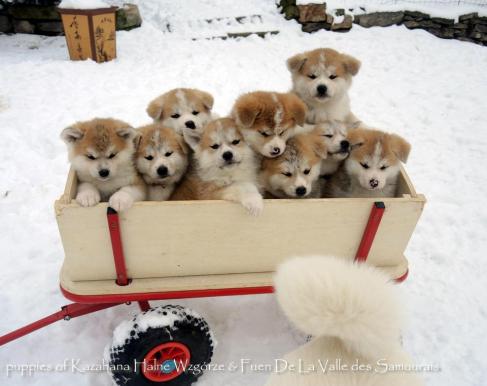
The Japanese Akita Inu
The Japanese Akita Inu. (above)
So many people ask what is the difference between the two breeds, so many get them confused! Once you know the differences you won’t ever struggle again! Here we will keep things simple for you. So about the Japanese Akita Inu (JAI)
- The Japanese Akita’s colors are limited to brindle, white, and red with white markings. Are only allowed to be red, white or brindle with no pintos or black masks. Red and brindle dogs are required to have white shading on face, chest, inside of legs and under tail
- Have a more ‘oriental’ look to them, especially in their face. Many say like a ‘fox’
- Are smaller, less boned and not as heavy than the Akita(American)
- BREED STANDARD. General Appearance
Large, well-balanced, sturdily built dog of Spitz type. Very slightly longer than high.Characteristics
Dignified. Broad head with relatively small eyes. Thick, triangular ears pricked and inclined forward. Distinctive tightly curled tail and markings.Temperament
Aloof, docile and faithful.Head and Skull
Head appears as a blunt triangle when viewed from above. Broad skull, free from wrinkle, with cheeks moderately developed. Defined stop with a distinct furrow. Muzzle straight, of good depth, tapering gradually. Lips tight. Nose large and black, except in white dogs where flesh coloured nose is acceptable.Eyes
Relatively small, almond-shaped, moderately set apart and dark brown. Eye rims dark and tight.Ears
Relatively small, thick, triangular, slightly rounded at tips. Set moderately well apart, pricked and inclining forward.Mouth
Jaws strong, with a perfect, regular and complete scissor bite, i.e. upper teeth closely overlapping lower teeth and set square to the jaws.Neck
Thick and muscular, of moderate length, without dewlap. Pronounced crest blending with back of skull.Forequarters
Shoulders well developed, moderately laid back. Elbows close to chest. Well boned. Forelegs straight when viewed from the front.Body
Length from point of shoulder to point of buttock slightly greater than height at withers. Level back. Chest deep, forechest well developed, ribs moderately sprung. Well tucked up. Loin broad and muscular.Hindquarters
Strong, muscular with moderate angulation. Well developed thighs. Moderate turn of stifle. Strong hocks, well let down, turning neither in nor out.Feet
Round, arched and tight with thick pads. Turning neither in nor out.Tail
Set high. Thick, full and of good length. Tightly curled over the back. Uncurled tail highly undesirable.Gait/Movement
Smooth gait with strides of moderate length. Vigorous and powerful. Stilted gait undesirable.Coat
Outer coat coarse, stand-off and straight. Slightly longer at withers and rump. More profuse on tail. Undercoat soft and dense. No indication of ruff or feathering.Colour
Red-fawn; sesame; brindle; white. All the foregoing colours except white must have whitish coat on the cheeks, the sides of the muzzle, the inside of the legs and also the undersides of the jaw, neck, chest, body and tail (Urajiro).Size
Height at withers: dogs 64-70cms (25 ¼-27 ½ ins); bitches 58-64 cms (22 ¾-25 ¼ ins).Faults
Any departure from the foregoing points should be considered a fault and the seriousness with which the fault should be regarded should be in exact proportion to its degree and its effect upon the health and welfare of the dog.Note
Male animals should have two apparently normal testicles fully descended into the scrotum
Our new puppy
Meet Arrow, he’s our new Japanese Akita Inu puppy. He’s between 7-Weeks old on these shots. He’s such a sweetheart but can be a big pain in the rear too! Bringing a new puppy into your home isn’t a decision that should be taken lightly. They need lots of love and attention, so if you’re thinking of an Akita puppy, think long and hard about it first. Do you have the time, do you have the patience for one? Will you be home all day for one? You can’t get a puppy if they’re going to be left alone for long periods of time. And remember an Akita isn’t like any other dog breed, RESEARCH them first, it is a must! Arrow developing really well into a very handsome young boy! We hope one day to get him in the show ring but first he needs puppy classes to learn some obedience! We always advise new comers to the Akita breed to seek a professional dog trainer or seek a local dog club that holds dog training classes, there’s never one too far away, they’re great fun and you and your Akita will learn lots! If an Akita puppy isn’t socialized at a young age with people, dogs, children and other animal and knows his right from his wrongs, trust us they will walk all over you. The last thing you want is a problem Akita. These are big powerful dogs and very dominant if you’re not his leader he will be yours. We currently have an 8 year old Akita, Alexus, she’s not letting him push her around and we are working hard to make sure they will co-exist peacefully. So far things are going great, Alexus has never been a mum and now Arrows here she’s got a child to look after, it will be good for her and him. We believe he will keep her young at heart, and give her that boost she needed. She has a new friend to keep her company. But if you struggle with one Akita and are thinking of another make sure you’re truly ready, twice the workload! We will keep you update on Arrow’s progress. He’s such a darling, very cheeky , playful and already trying to prove himself! We sure do have our hands full.
- Arrow! 7-9 weeks old.


